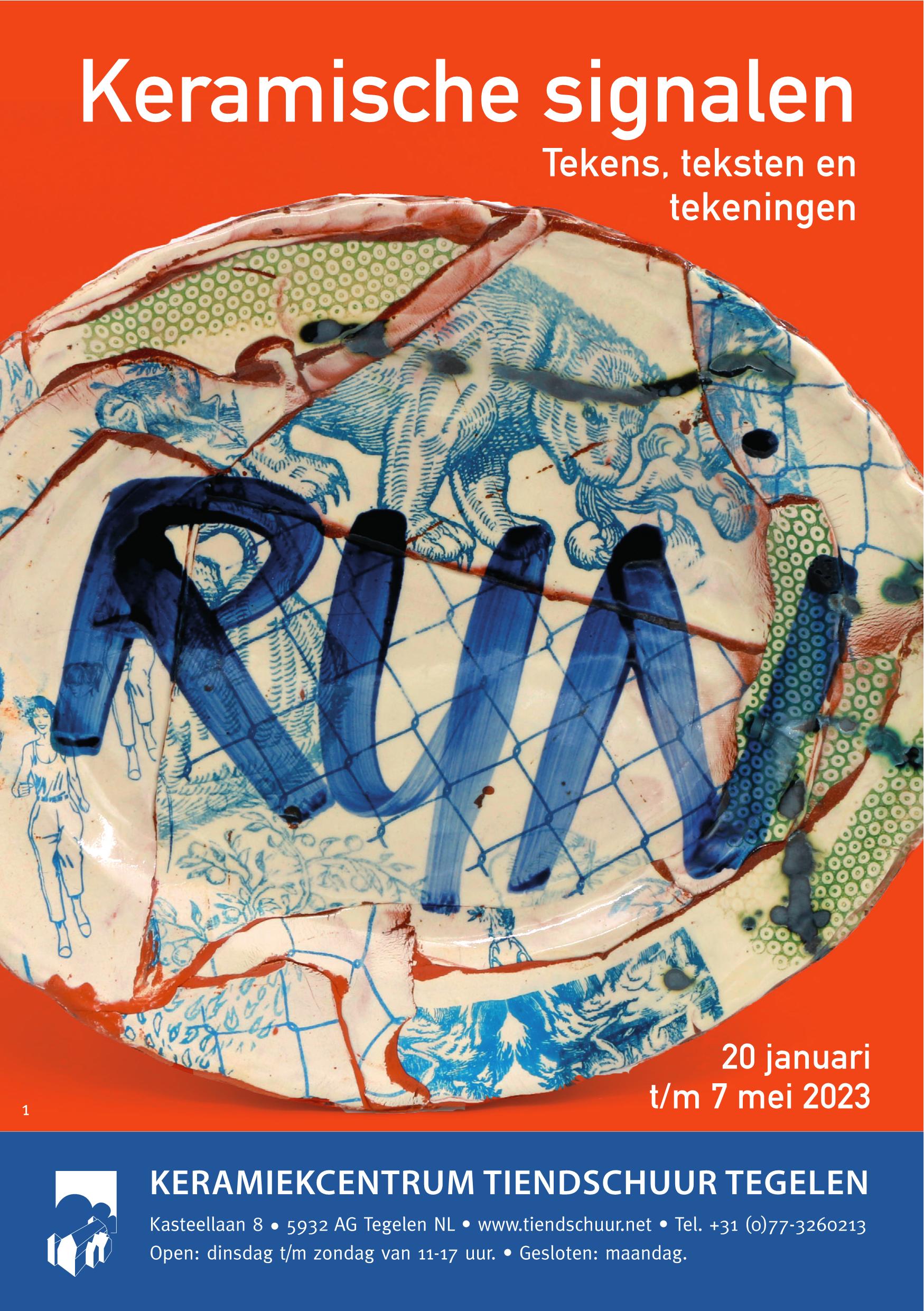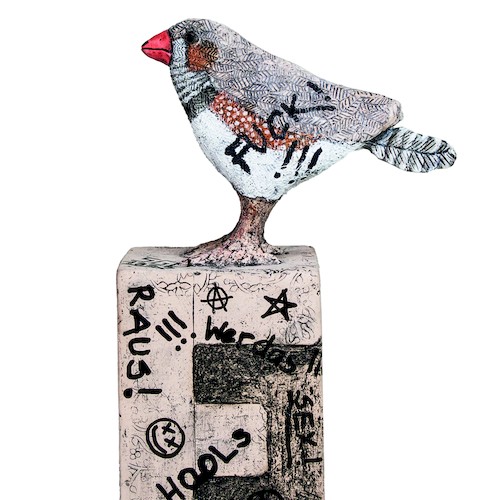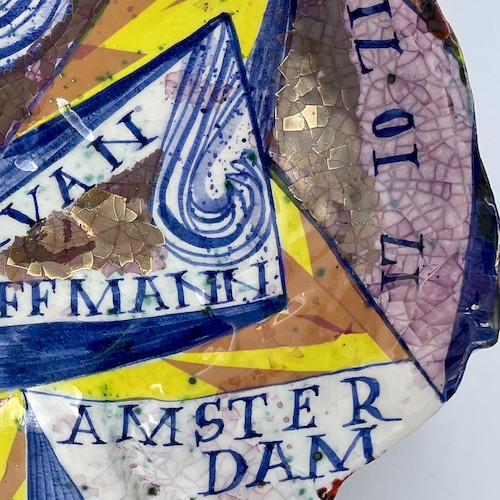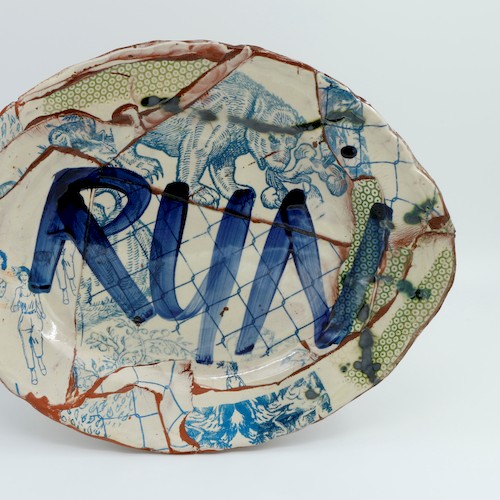
From funny word games to angry protests
Ceramic art with a message at Keramiekcentrum Tiendschuur Tegelen.
from 20 January up to and including 7 May 2023
The exhibition Ceramic signals, signs, texts and drawings, makes visitors curious. It calls on them to go and search for the messages the art objects carry in them. One work also contains signs that look purely aesthetic and abstract, another is fashioned with funny comic strips and yet another is strewn with very explicit, careless graffiti texts and protests against the wrongs in this world. This exhibition shows a curiosity-arousing collection of ceramic works of art from renowned artists from home and abroad. Their work is very different, but all of it comes with a message and is beautifully decorated.
Sylvian Meschia (FR) provides his work with beautiful calligraphic signs strongly reminding one of Arabic writing. His roots in Algeria clearly show here. His objects look like thrown functional ware, but they are self-contained works of art. Sylvian provides his work with exotic decorations, with, among other things, a self-conceived alphabet. He applies this using clay slips, colour pigments and sgraffito. The figures he puts with a paint brush strongly remind one, apart from Arabic calligraphy, also strongly of Eastern calligraphy.
Someone who has a passion for calligraphy, too, is Yeung Yuk-Kan (NL). She has been living and working in the Netherlands for years, but was born in Hongkong and studied visual arts there at the University of Hongkong. She shapes her porcelain objects deliberately in such a way that they strongly remind one of paper. In a modest way, she applies signs and decorations to it. Her tranquil and poetical objects have just as much empty white space as the paper in the Chinese and Japanese calligraphy.
Large empty areas and powerful calligraphic brushstrokes can also be found in Karin Bablok's work. This Hamburg ceramicist restricts her palette to a modest black-and-white. She only adds a few powerful black brushstrokes to her virginal porcelain forms. They sometimes remind one of Japanese calligraphy and sometimes of our first writing exercises.
Another exhibitor who seems to have selected writing exercises or a dance of letters as a theme for her decorations is German Monika Debus. Quick brushstrokes and exuberant curls, loops and dots embellish the skins of her objects. Simplicity, spontaneity and great pleasure splash from her work.
Pleasure and humour can also be found in the work from Ute Naue-Müller (Dresden, Germany). Her objects are provided with playful decorations with an interaction between word and image, content and form. Her accessible representations are sweet, mischievous and funny at the same time.
The painted little stories by the French couple Marie Balme and Simon Bellégo are also sweet and moving. Their representations are a feast for the eye. They would not be out of place as hip illustrations in prominent magazines. Fortunately, they chose ceramics rather than paper. You can also find little stories or fairy tales on the work from the Spanish couple Ricardo and Rosa Campos-Rosell. Their black-on-black decorations are particularly attractive. They strongly remind one of old-fashioned negatives and yellowed photographs from long-ago days.
Long-ago days can also be found in José Den Hartog’s work. This Dutch artist works mainly on commission and in the style of the traditional delft blue. But actually only the technique and her colour palette are identical to the traditional Dutch decorations. Who looks a bit longer, will see that her decorations are anything but old-fashioned. She designs complicated and alienating patterns which she constructs with geometrical forms and details from historical decors which repeats again and again.
Alienating also is the rough work from Ruan Hoffmann. This South-Africa born artist lives and works in Amsterdam. As a basis, he uses familiar earthenwork forms such as plates, dishes and tiles. He then reforms them, providing them with confrontational texts and images. On his objects he puts personal experiences, uncensured observations and comments on our time and society. He creates a dialogue between form and content, between work of art and spectator.
Protest art and black humour can also be found in the work by Rita de Nigris. This Italian-Swiss ceramicist used to be known especially for her decorations consisting of caricatural human figures with huge noses. Nowadays, she provides her work with texts to which she adds subtle images. In addition, she gives her work an atmosphere of degeneration and decline by breaking it and sticking it together again and covering it a with graffiti-like ‘mess’. The longer you look, the more puns, ambiguities and funny messages you will discover in her creations.
This exhibition Ceramic signals challenges the visitors to look further, to distinguish phantasy letters from real ones and to unravel secret messages. But above all, to come and enjoy surprising ceramic works of art made by renowned artists from across Europe, all of whom love playing with letters, form, representation and meaning.
Opening
Opening: Friday 20 January 2023, 16:00.
Some artists will be present in person at the opening of the exhibition. The introduction will be presented by Conservator/ manager Sacha Odenhoven.
Exhibitors
Karin Bablok (DU), Marie Balme en Simon Bellégo (FA ), Ricardo en Rosa Campos-Rosell (SP), Monika Debus (DU), Jose den Hartog (NL), Ruan Hoffmann (ZA), Sylvian Meschia (FR), Ute Naue-Müller (DE), Rita de Nigris (CH/ I), Yeung Yuk-Kan (NL)
Some artists will give a lecture or a workshop about their work:
- Karin Bablok, lecture at 22 January 2023, 14:00
- Marie Balme and Simon Bellégo, lecture at 7 May 2023, 14:00
- Ute Naue-Müller, workshop at 16-17 december 2023
Please book a place for the lecture in advance.
Please book here for the workshops
For more information: www.tiendschuur.net, or contact Sacha Odenhoven - curator/manager - (info@tiendschuur.net of 077-3260213).




